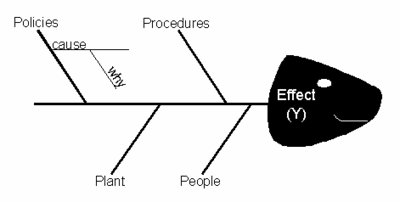Decision Tree: Risk & Opportunities
(→Identification) |
|||
| Line 18: | Line 18: | ||
== Identification== | == Identification== | ||
[[File:Fishbone.gif|400px|right|thumb|Figure 1. Cause and effect diagram (fishbone)<ref name="Fishbone"/>]] | [[File:Fishbone.gif|400px|right|thumb|Figure 1. Cause and effect diagram (fishbone)<ref name="Fishbone"/>]] | ||
| − | For the project manager it is important to identify the risks before a decision is made. Best decisions are based on information therefore it is crucial for a good project manager to start early in a project to gather information. Having the information early on will mitigate the possibility of an unforeseen event occurring. However even the best project manager will not be able to predict all risks within the projects timeline. | + | <ref name="Managing">For the project manager it is important to identify the risks before a decision is made. Best decisions are based on information therefore it is crucial for a good project manager to start early in a project to gather information. Having the information early on will mitigate the possibility of an unforeseen event occurring. However even the best project manager will not be able to predict all risks within the projects timeline. |
All information must be processed and put in the right categories to be successfully used. This include positive and negative outcomes (opportunities and threats for the project) | All information must be processed and put in the right categories to be successfully used. This include positive and negative outcomes (opportunities and threats for the project) | ||
There are different kind of tools to help the project manager and his/hers team to identify and manage the risks. One is to stimulate and the capture the ideas from the teams brainstorming on the root of the causes with the cause and effect diagram a.k.a Fishbone<ref name="Fishbone"/>.<br> | There are different kind of tools to help the project manager and his/hers team to identify and manage the risks. One is to stimulate and the capture the ideas from the teams brainstorming on the root of the causes with the cause and effect diagram a.k.a Fishbone<ref name="Fishbone"/>.<br> | ||
Revision as of 18:17, 1 October 2017
Uncertainty is a massive issue in project management and can lead to high cost and negative impacts if not handled correctly. The project manager must therefore be able to make the best decisions based on the information available.
First the project manager must be able to localize risks and gather information on the problem.
Then the project manager becomes the decision makers as he will have to analyse and med choices on the obtained information.
The decision tree is a tool that can aid the project manager to ensure the best outcome of a problem.
It is based on a tree-like model where each branch is a path of decisions and possible events. Each step include the cost and possibility of that event to occur.
By identifying all the possible events and their chance to occur it gives the project manager the ability to calculate the highest probability for each path.
When combining this with the cost of each event the project manager is able to estimate the cost/benefits for each decision.
This article will also have a look on the decision trees limitations and some alternatives for decision making tools.
Introduction
Decisions and uncertainties is something we experience almost every day. It might not be huge deal for the normal person. However for a project manager decisions and uncertainties can be huge and costly problems if not handled correctly. It is therefore important for the project manager to be able to localize and do problem solving in the best way. To make a qualified decision there are four steps the manager should go through[1]
1: Identification of the problem and gather proper information
2: Identify limitations
3: Find alternatives and analyse them to select the best solution
4: Apply the solution to the problem and monitor the outcome
There are many different tools to aid the project manager with this. The decision tree is one of those tools which can aid the decision-maker in his process. The decision tree is a way to structure decision and the probability of events that occur from the decision. With information as consequence of each event the project manager is able to select the best expected outcome.
Identification

Cite error: Closing </ref> missing for <ref> tag
Cite error:
<ref> tags exist, but no <references/> tag was found